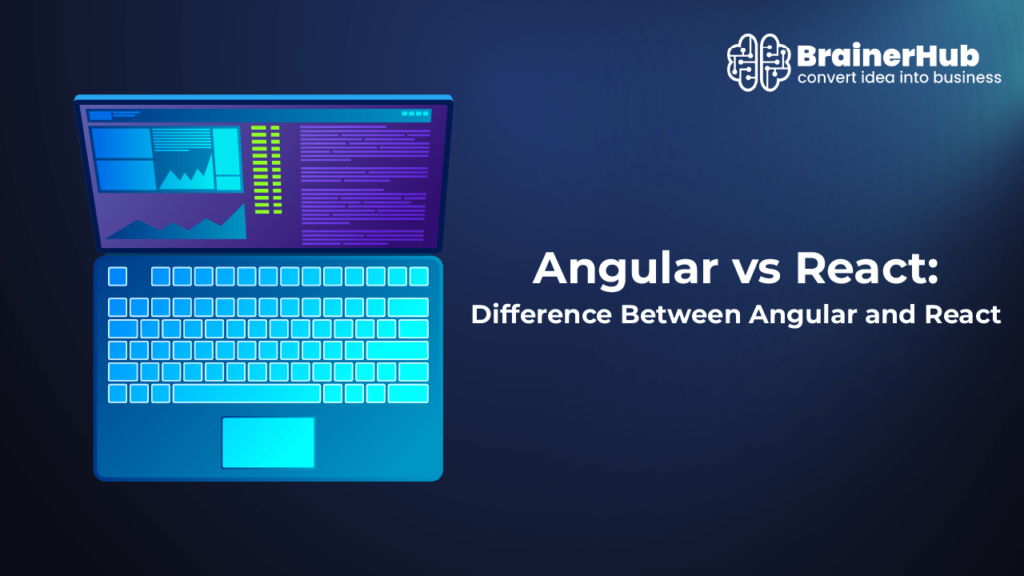Angular vs. React is a hot debate in the mobile and desktop web app development community. Businesses face this common dilemma when embarking on web development projects. The decision can significantly impact the success of your project, so it’s crucial to weigh both frameworks and understand their pros and cons, advantages and disadvantages, to find the suitable one for you.
The dilemma of Angular vs. React Which is Best is valid, but there is no definitive answer to it. Each framework has its merits and drawbacks, and you can successfully employ either for various projects.
Both of these frameworks were developed by tech giants Google and Facebook (now Meta), respectively. They have gained immense popularity in the web and app development community. They are both highly versatile; however, to make an informed choice for your business, it’s essential to understand your unique requirements and how the advantages and disadvantages of each framework complement your objectives.
In this comprehensive comparison, we’ll explore the much-debated topic of AngularJS vs. ReactJS to help you make an informed decision for your project requirements.
What is React?
ReactJs Development is a JavaScript library developed by Facebook (Meta) in 2013. It’s primarily used to build user interfaces, particularly large-scale web applications. React is one of the most popular frameworks in the realm of web development currently, and its widespread popularity can be credited to its efficiency, flexibility, and ability to create dynamic and interactive user interfaces.
Understanding React vs. Angular Which is Better, demands understanding both frameworks in detail. React offers versatility and performance, making it suitable for a wide range of web development projects, from single-page applications (SPAs) to large-scale, data-intensive applications. Moreover, it has developed a strong and active community of developers, ensuring ongoing support and continuous innovation.
What does React have Over Angular?
The discussion of Angular vs. React is incomplete without discussing what they have over each other. In this first section, we will explore what are the aspects of React that surpass Angular.
Angular and React are both powerful tools for web development, but they have different approaches and strengths. While React has these advantages, it’s essential to note that we are not trying to argue the case of React vs. Angular Which is Better. The choice between React and Angular ultimately depends on project requirements, team expertise, and development preferences.
React’s flexibility and performance make it a compelling choice for many web development projects, especially those with a focus on building dynamic user interfaces and cross-platform mobile applications.

Here are some of the major benefits of React:
- Flexibility and Lightweight: React is a library, while Angular is a framework, which means React is more lightweight and flexible. When it comes to React, developers have the freedom to choose additional libraries and tools to build their applications, giving them more control over the project’s architecture.
- Component-Based Architecture: Although the debate, Angular vs. React Which is Best, has no definite answer, we must admit that React’s Component-Based architecture is supreme. React’s highly modular component-based architecture encourages code reusability. It allows developers to create encapsulated components that are easy to manage and test. This makes React well-suited for building complex user interfaces.
- Virtual DOM: React’s virtual DOM is a key feature that enhances its performance compared to its counterparts. It allows React to efficiently update only the parts of the actual DOM that have changed, reducing unnecessary re-rendering and improving the application’s speed.
- One-Way Data Binding: React follows a unidirectional data flow, making it easier to understand and debug data changes. The one-way data binding in React simplifies the development process and reduces the risk of unexpected side effects.
- JavaScript and JSX: One crucial Difference Between Angular and React is that React uses JavaScript and JSX, a syntax extension that allows developers to write HTML-like code within JavaScript. The JSX approach provides more flexibility and is more familiar to many developers, especially those already proficient in JavaScript.
- Large Ecosystem: React has a vast ecosystem of third-party libraries and tools that can be integrated into projects as needed. This extensive ecosystem flexibility allows developers to choose the best tools for their specific requirements.
- React Native: React’s ability to build cross-platform mobile applications with React Native is another significant advantage. Developers can share a substantial portion of their codebase between web and mobile applications while using React Native, saving time, resources, and effort.
- Learning Curve: React is often considered to have a gentler learning curve than Angular, especially for developers familiar with JavaScript.
- High Performance: React’s virtual DOM (Document Object Model) allows for efficient updates to the user interface. React reduces rendering time by minimizing direct manipulation of the actual DOM, resulting in better performance and a smoother user experience.
What is Angular?
The second step of our Angular vs. React is to define and understand the Angular framework. Angular is a comprehensive JavaScript framework developed by Google. Angular is primarily used to build dynamic, single-page web applications and has evolved into a full-fledged ecosystem for web development.
Angular, developed by Google, is a comprehensive front-end development framework for building dynamic web applications. It was first introduced in 2010 and has since evolved into Angular 2+, sometimes referred to simply as Angular. Angular is designed to provide developers with a complete solution for developing modern web applications, offering a structured approach to application development.
What does Angular have Over React?
To evaluate Angular vs. React and determine which one is better for a particular project, it’s essential to understand the strengths and weaknesses of both frameworks. Both React and Angular have their merits and are suitable for different scenarios.
Angular’s strengths lie in its attributes, such as a comprehensive framework, two-way data binding, mature ecosystem, strong typing with TypeScript, detailed documentation, etc. Another characteristic that plays a vital role in Angular vs. React Which is Best discussion, is that Angular is backed by the tech emperor of the globe, i.e., Google.
These unique attributes make Angular a strong contender for large-scale and complex web development projects, particularly those requiring a structured approach and extensive out-of-the-box features.
However, the choice between Angular and React ultimately depends on the specific project requirements and development team expertise.

Benefits of Angular:
The Angular vs. React debate is the same as comparing apples and oranges. Both Angular and React are potent tools for web development and offer their own set of advantages that distinguish them in the developer community. Here are some major benefits of Angular:
- Comprehensive Framework: Angular is a complete front-end framework providing an opinionated structure for web application building. It includes a wide range of built-in features, such as routing, form handling, and dependency injection. Using this comprehensive nature, developers can expedite development by reducing the need for external libraries.
- Strongly Typed: Angular is built with TypeScript, meaning that Angular applications benefit from solid type checking, which can catch errors at compile time rather than runtime. It is one of the determinants of Angular vs. React Performance and is particularly valuable for large, complex projects where type safety is crucial.
- Two-Way Data Binding: Angular’s two-way data binding simplifies real-time data updates. It enables automatic synchronization between the model and view, which can be advantageous for certain types of applications.
- Enterprise-Ready: Angular is well-suited for building large-scale enterprise applications. Its robust toolset, structured architecture, and strong support for scalability make it a solid choice for complex projects.
- Consistency and Opinionation: Angular enforces a consistent development structure and coding patterns, which can be advantageous in large development teams or projects where maintaining code consistency is critical.
- Backward Compatibility: Google’s commitment to Angular ensures backward compatibility and long-term support. This stability can be reassuring for businesses with projects that have extended life cycles.
- Built-In Testing Tools: Another attribute that cannot be missed in the discourse of React vs. Angular Which is Better is Angular’s built-in testing capabilities. It provides built-in support for testing, making it easier to implement automated testing and quality assurance in your projects.
- Full-Fledged Framework: Angular is a comprehensive front-end framework that provides a clear structure for building web applications. It includes built-in features such as routing, forms handling, dependency injection, and more. This opinionated structure can benefit larger development teams working on complex projects.
- Maintained by Google: Angular is developed and maintained by Google, assuring long-term support and updates. Google’s commitment to Angular ensures its continued relevance in the web development landscape.
Difference Between Angular and React
Angular and React have emerged as two prominent JavaScript technologies in the web application development arena for building modern and robust solutions. The debate of Angular vs. React Which is Best has been going on for a while now, and to aid developers and businesses in making informed decisions, we have created a comprehensive comparison between Angular and React, highlighting their key differences across various aspects.
Aspect | Angular | React |
Type | Comprehensive front-end framework | JavaScript library for building user interfaces |
Architecture | Uses MVC (Model-View-Controller) architecture | Uses component-based architecture |
Templating | HTML templates with Angular-specific syntax | JSX (JavaScript XML) for defining components |
Ecosystem | Mature and extensive ecosystem | Rich ecosystem with third-party libraries |
Learning Curve | Steeper learning curve, especially for beginners | Gentler learning curve, especially for JavaScript developers |
Tooling and CLI | CLI (Command Line Interface) for project setup and management | Create React App for project setup and management |
Mobile Development | Ionic framework for hybrid mobile apps | React Native for cross-platform mobile app development |
Community Support | Large and established community | Active and growing community |
Backed by | Developed and maintained by Google | Developed and maintained by Facebook (Meta) |
Dependency Injection | Built-in dependency injection system | External libraries can be used for dependency injection |
Flexibility | Opinionated and structured approach | More flexible, allowing integration of other tools and libraries |
TypeScript Integration | Strong TypeScript support | TypeScript can be used but is optional |
Development Speed | Slower initial setup due to a complex project structure | Faster setup with a simpler project structure |
State Management | Typically uses services and RxJS for state management | State management libraries like Redux can be integrated |
Testing | Built-in testing tools (Jasmine, Protractor) | Various third-party testing libraries |
SEO | Requires additional setup for SEO optimization |

Detailed Comparison: React Vs Angular
Now, to extend our Angular Vs React discourse and provide you with a comprehensive but in-depth comparison of React and Angular, we have created another table to highlight various aspects that can influence the choice of framework or library for a web development project. Understanding these differences is essential for developers and businesses seeking to make informed decisions in the React vs. Angular debate.
Consideration | React | Angular |
Popularity | Popularity is an important parameter of our discussion about React Vs Angular Which is Better. React enjoys immense popularity in the JavaScript community. It is often regarded as one of the most preferred libraries for building user interfaces. Its widespread adoption is due to its simplicity, flexibility, and strong developer community. | Angular is also highly popular and has a large following of developers. Developed and maintained by Google, it has gained prominence for its structured approach to building web applications. It remains a solid choice, particularly for large-scale enterprise projects. |
Data binding | React employs one-way data binding, also known as unidirectional data flow. This model’s data flows in a single direction, from parent to child components. This approach simplifies understanding of data changes and reduces the likelihood of unintended side effects, enhancing predictability and debugging. | Conversely, Angular uses two-way data binding, which enables bidirectional communication between the view and the model. While this can simplify certain aspects of development, it may lead to more complex code and potentially make it harder to track data changes. |
Components | Components tell us a lot about Angular vs. React Performance matrices. These are modular, self-contained building blocks of a user interface. They encourage code reusability, maintainability, and a structured approach to UI development. React uses component-based architecture and can easily be composed to create complex user interfaces. | Angular shares a similar emphasis on component-based development. Angular components are reusable, encapsulated entities with their own logic, templates, and styling. This architecture fosters clean separation of concerns and supports the creation of scalable, maintainable applications. |
UI Components | React boasts a thriving ecosystem of third-party libraries and components. Developers can tap into a vast repository of pre-built UI components, allowing for faster development and access to a wide range of functionalities. The React community actively contributes to this ecosystem, resulting in a wealth of choices. | Angular provides a range of built-in UI components, offering a comprehensive set of tools for creating user interfaces. These components are designed to work seamlessly with Angular applications. While the selection of built-in components is extensive, it may not offer the same diversity as React’s third-party libraries. |
DOM | React utilizes a virtual DOM (Document Object Model) for rendering and updating the user interface. The virtual DOM is an in-memory representation of the actual DOM, enabling React to efficiently update only the parts of the page that have changed. This approach minimizes DOM manipulation, resulting in enhanced performance and responsiveness. | Angular interacts directly with the actual DOM. Changes in the application’s state trigger updates to the DOM elements. While this approach can be effective, it may require careful optimization to avoid unnecessary re-renders and maintain performance in large applications. |
Tools | React relies on a rich ecosystem of third-party tools and libraries for various tasks such as state management, routing, and form handling. This flexibility allows developers to choose tools that best fit their project’s requirements. | Angular provides a Command Line Interface (CLI) for project management. The Angular CLI streamlines tasks such as scaffolding projects, generating components, and running tests. It offers a convenient way to get started with Angular development. |
Performance | Angular vs. React Performance is a highly detachable topic. React is renowned for its exceptional performance, thanks to the virtual DOM and one-way data binding approach, which results in faster rendering and a smoother user experience, making React ideal for dynamic web applications. | Angular offers good performance but may require careful optimization, especially in larger applications. Developers need to manage DOM updates effectively to ensure smooth user interactions. While Angular provides tools for optimization, it may involve a steeper learning curve for performance tuning. |
Directives | Another Difference Between Angular and React is that React uses JSX (JavaScript XML) for defining component structures. JSX allows developers to write HTML-like code within JavaScript, enhancing code readability and maintainability. | Angular employs directives and special markers in the markup to extend HTML functionality. Directives allow developers to add behavior to DOM elements and create custom reusable HTML tags. |
Language | React primarily uses JavaScript and JSX syntax. JSX is a JavaScript extension that allows developers to write HTML-like code within JavaScript. This combination simplifies the creation and management of user interface elements, making the code more expressive and easier to work with. Developers familiar with JavaScript will find it comfortable to work with React. | Angular is built with TypeScript, a statically typed superset of JavaScript. TypeScript adds static typing to JavaScript, enhancing tooling support, code quality, and developer productivity. While TypeScript offers benefits, it may require developers to learn a new language if they are not already familiar with it. |

React Vs Angular: When to Choose What?
While the debate about Angular Vs React Which is Best can go on and on, you should have a pretty clear idea about both frameworks. Now, we would like to go further into this rabbit hole of Angular Vs React to understand when to choose which framework.
Choose Angular When:
- Enterprise-level Applications: Angular is well-suited when you are building large-scale, enterprise-grade applications that require extensive features, structured architecture, and strong tooling support.
- Strong Typing and Code Quality: If you require strong typing and enhanced code quality, you have a compelling reason to choose Angular.
- Full-Featured Framework: When you need a comprehensive framework that includes built-in solutions for routing, forms, HTTP requests, and more, Angular provides a complete package.
- Robust Ecosystem: Ecosystem is a crucial part of our Angular Vs React discussion. If you prefer relying on a well-established ecosystem with an extensive set of official libraries and components, Angular offers an excellent choice.
- Structured Approach: When your project benefits from a structured and opinionated approach to development, Angular might be a better option.
When to Choose React:
- Dynamic User Interfaces: React excels at building dynamic and interactive user interfaces. If your project requires real-time updates and a responsive UI, React is a strong choice.
- Component Reusability: When you are looking for code maintainability and reusability, React offers a flexible approach.
- Large Ecosystem: React boasts a vast ecosystem of third-party libraries and components. If you want the flexibility to integrate a wide range of tools and libraries into your project, React provides is the way to go!
- Cross-Platform Development: When you’re interested in developing both web and mobile applications using a shared codebase, React’s compatibility with React Native allows you to achieve this efficiently.
- Gentle Learning Curve: When your team is already familiar with JavaScript, React is often considered to have a gentler learning curve, making it a better choice.
Angular Vs React Which is Better?
Yes, our answer is still the same. There’s no definitive “better” choice; it depends on your project. The choice of framework will always be determined by what the project demands.
However, to give you the crux of our Angular vs React debate, choose Angular for structured, enterprise-level apps and strong typing. Opt for React for dynamic, interactive UIs, component reusability, and a vast ecosystem.
The choice between Angular vs React depends on the unique requirements of your web development project, your team’s skills, and your preferred development philosophy. Remember that the success of your project often hinges on factors beyond the choice of framework, such as effective project management, collaboration, and a clear understanding of your target audience and goals.
Are oranges better than apples? Yes, the answer is subject and varies from one person to another and one season to the other. Similarly, one framework does not have superiority over the other. We completely agree that in some specific aspects, they do surpass each other, but when you take a generalized view, you see that they are both good and suitable for different methodologies, approaches, and project demands.
Angular is favored for structured, enterprise-level apps, while React shines for dynamic UIs and component reusability.
No, the general consensus is that the learning curve of Angular is steeper as compared to React. However, the ease of learning Angular vs React varies.
It is not an objectively established fact that React is better than Angular. Yes, React is preferred for its dynamic UIs, component reusability, vast ecosystem, and cross-platform capabilities through React Native. However, the choice between React and Angular depends on your project’s needs.
TypeScript is similar to JavaScript but comes with an added benefit. It helps catch errors in your code before you even run it, making your coding experience smoother and less error-prone. On the other hand, JavaScript is the core language of web development. It’s flexible, but you need to be extra cautious when coding to avoid unexpected issues.

